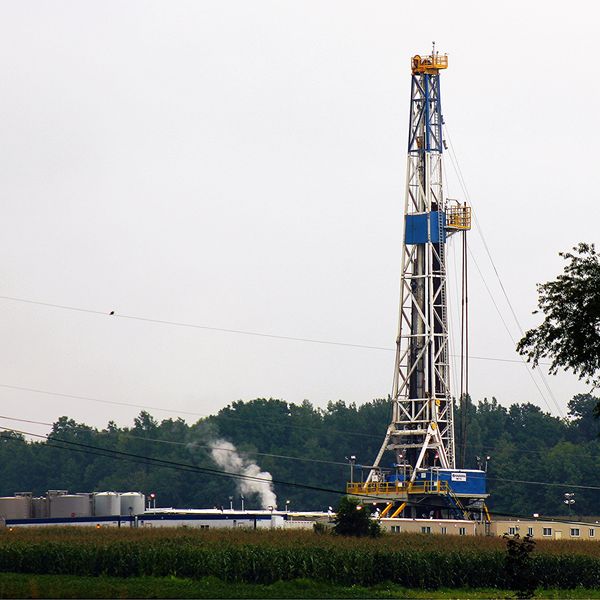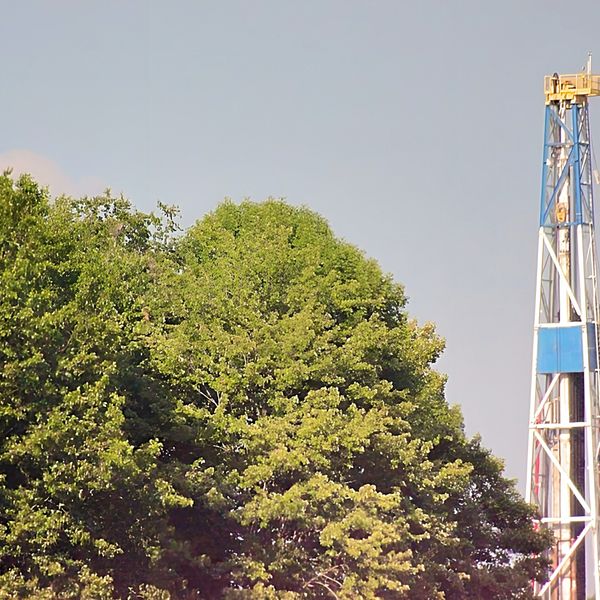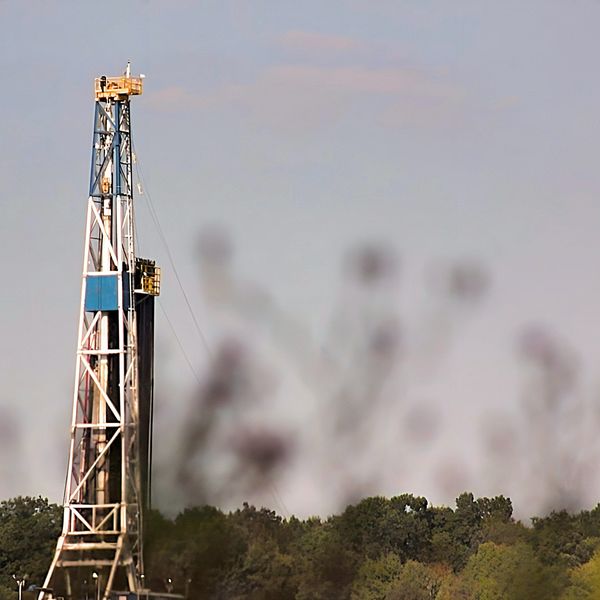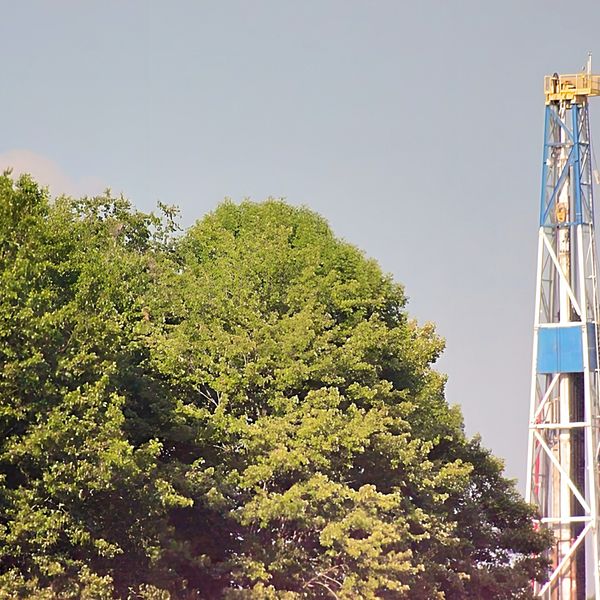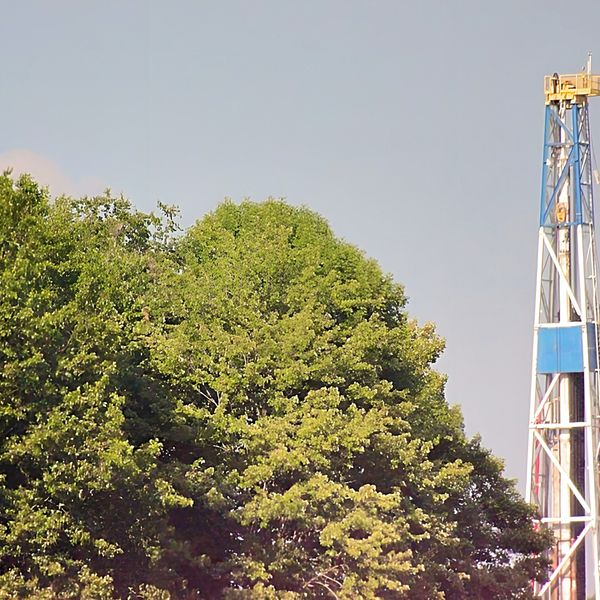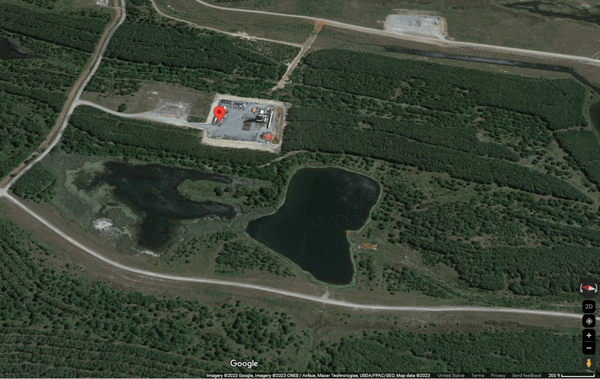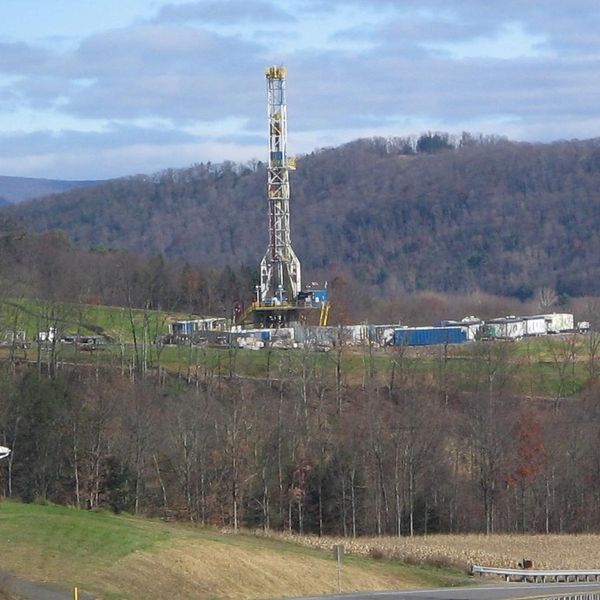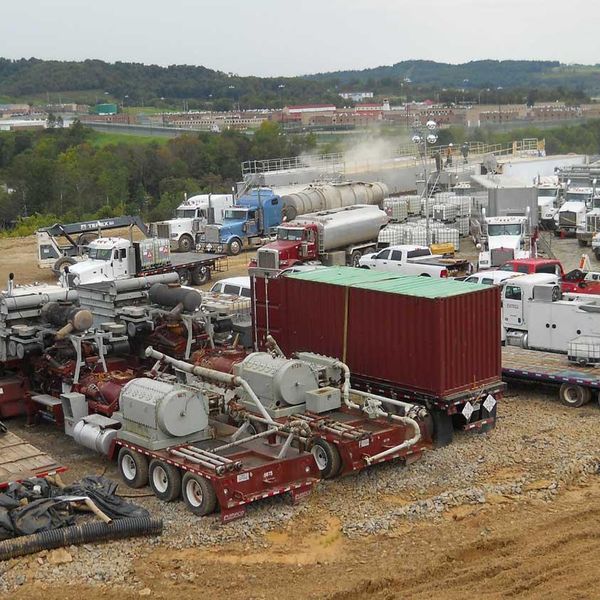This is part 1 of our 4-part series, "Fractured," an investigation of fracking chemicals in the air, water, and people of western Pennsylvania.
WASHINGTON COUNTY, Pa.—In the summer of 2019, 13-year-old Gunnar Bjornson spent most days banging on his drums, playing video games, antagonizing his siblings, wandering outdoors, and scrounging for junk food in his home's mostly healthy kitchen.
Gunnar is tan and blond with bright blue eyes and all the charisma required to survive being the younger of two middle children in a big family. He's the household entertainer, constantly cracking jokes and falling into contagious giggling fits.
Gunnar lives with his mom, dad, older brothers and younger sister about 35 miles south of Pittsburgh in the aptly-named community of Scenery Hill, where narrow country roads wind through shady woods that open up onto hilltop vistas of rolling fields. The hills are peppered with farmhouses, fruit orchards, and fields of corn and squash. The roadsides are punctuated by little white churches, farm stands, and dirt driveways marked with hand-painted signs like "The Jones's" and "Hidden Family Farm."
Scenery Hill is in Washington County, the most heavily fracked county in Pennsylvania, with about 1,584 wells in its 861 square miles, so the idyllic country roads are also flanked with signs directing oil and gas well traffic: "No well traffic beyond this point," "Staging area ---->," "Truck traffic: No engine breaks," and ads that read, "We buy mineral rights!"
August 19, 2019, was a typical day for Gunnar—he played drums, took the dog outside, and argued and joked with his siblings. But unbeknownst to him and his family, Gunnar had a number of harmful chemicals coursing through his body.
A urine sample taken from Gunnar that day contained 11 harmful industrial chemicals, including benzene, toluene, naphthalene, and lesser-known chemicals linked to a range of health effects including respiratory and gastrointestinal problems, skin and eye irritation, organ damage, reproductive harm, and increased cancer risk.
These chemicals are found in things like gasoline, pesticides, industrial solvents and glues, varnishes, paints, car exhaust, industrial emissions, and tobacco smoke. They're also commonly detected in air emissions from fracking wells.

Gunnar Bjornson in his family's Scenery Hill, Pennsylvania, home. (Credit: Connor Mulvaney for Environmental Health News)
Fracking, another name for hydraulic fracturing, is the process of extracting oil and gas from the Earth by drilling deep wells and injecting liquid at high pressure. Over the last decade, fracking has transformed the U.S. energy industry—total crude oil production more than doubled from 2010 to 2020, and natural gas, once in short supply, is now so over-abundant it's exported overseas. But in that same time period, concerns about the health effects of fracking have escalated.
In Texas, researchers found that babies born near frequent flaring—the burning off of excess natural gas from fracking wells—are 50 percent more likely to be premature. In Colorado, the state Department of Health found that people living near fracking sites face elevated risk of nosebleeds, headaches, breathing trouble, and dizziness. In Pennsylvania, researchers found that people living near fracking face increased rates of infant mortality, depression, and hospitalizations for skin and urinary issues. Studies of fracking communities throughout the country have found that living near fracking wells increases the risk of premature births, high-risk pregnancies, asthma, migraines, fatigue, nasal and sinus symptoms, skin disorders and heart failure; and laboratory studies have linked chemicals used in fracking fluid to endocrine disruption—which can cause hormone imbalance, reproductive harm, early puberty, brain and behavior problems, improper immune function, and cancer.
"We have enough evidence at this point that these health impacts should be of serious concern to policymakers interested in protecting public health," Irena Gorski Steiner, an environmental epidemiology doctoral candidate at the Johns Hopkins Bloomberg School of Public Health, told EHN (EHN).
EHN has reported on this increasing evidence of fracking's impacts on human health for years. But we saw a gap in the science—almost no one was checking to see if harmful fracking chemicals were actually in the bodies of people living near wells. In 2019, EHN collected urine samples, along with air and water samples, from five families in southwestern Pennsylvania, including the Bower-Bjornsons, and had them analyzed for chemicals associated with fracking. We found:
- Chemicals in water, air and urine samples that are linked to a wide range of harmful health impacts
- Cancer-causing chemicals in air samples at levels that exceeded recommended safety thresholds
- Biomarkers (also referred to as breakdown products or metabolites) for harmful chemicals like ethylbenzene, styrene, and toluene in the bodies of southwestern Pennsylvanians at levels significantly higher than the average American. For example, we found a biomarker for toluene in a 9 year-old boy living near fracking wells at a level 91 times as high as the level seen in the average American
- Families that live closer to fracking wells had higher levels of chemicals like 1,2,3-trimethylbenzene, 2-heptanone, and naphthalene in their urine than families that live further away. Exposure to these compounds is linked to skin, eye, and respiratory issues, gastrointestinal illness, liver problems, neurological issues, immune system and kidney damage, developmental issues, hormone disruption, and increased cancer risk.
Read about how we conducted our study
We collected a total of 17 urine samples from Gunnar and his family during the summer of 2019. Some chemical exposures aren't detectable in urine if the body has already broken them down, so we also looked for breakdown products, or biomarkers, of harmful chemicals. The presence of these chemicals and their biomarkers in urine generally reflect exposures that occurred within a few days of sampling.
Some of these biomarkers have sources other than these chemicals. For example, trans, trans-muconic acid is a biomarker for benzene, but eating sorbic acid (a common food preservative) also produces trans, trans-muconic acid. Hippuric acid is a biomarker for toluene, which can damage the nervous system or kidneys, but it's also formed when the body processes tea, wine, and certain fruit juices. As a result, we expect everyone to have a certain level of these compounds in their bodies. To determine whether the levels we saw in Pennsylvania families were normal, we compared the levels of these biomarkers in the families we tested to the levels seen in the average American using U.S. Centers for Disease Control and Prevention (CDC)'s National Health and Nutrition Examination Survey.
More than half of the family's samples exceeded the U.S. 95th percentile for phenylglyoxylic acid, a biomarker for ethylbenzene and styrene, and 41 percent of the family's samples exceeded the U.S. 95th percentile for hippuric acid and trans, trans-muconic acid—biomarkers for toluene and benzene, respectively. Exposure to these compounds is linked to skin, lung, and eye irritation; central nervous system, liver and kidney damage; and cancer.
Gunnar's urine sample contained a level of mandelic acid, a biomarker for ethylbenzene and styrene, 55 times as high as the average American (according to CDC data) and higher than levels typically seen in the average adult cigarette smoker.
Mandelic acid isn't itself harmful—it's used in small amounts in some medicines and skincare products—but exposure to ethylbenzene and styrene is linked to skin, eye, and respiratory tract irritation, reproductive harm, endocrine disruption, and increased cancer risk.
A few years ago, when drilling began simultaneously at three of the fracking well pads within a few miles of the Bower-Bjornson home, Gunnar frequently got nosebleeds that lasted up to 20 minutes and drained all the color from his face. Sometimes he'd cough up blood clots afterwards. Once, he recalled, this happened at school and he asked his teacher not to tell his mom about it, knowing it worried her.
Gunnar still gets nosebleeds, but they're less frequent now that all three of those wells are in production—meaning they're no longer actively drilled and fracked, but are producing oil and gas. They aren't the only three wells nearby. The family's home is within five miles of at least 25 active well pads, many of which contain multiple wells. The nearest pad, owned by Pittsburgh-headquartered EQT Corporation—the largest producer of natural gas in the country—is home to 10 operational wells.
There's no way to know for certain whether Gunnar and his family's exposures came from fracking emissions. We looked for other potential sources of exposure by visiting their home, asking them to complete an extensive survey, and recording their activities around the time of our sampling.
On the days we collected samples, the family generally engaged in normal summer activities—running errands, working in the garden, and lounging around the house. When we observed other potential sources of exposure, they're noted in our reporting. To our knowledge, the Bower-Bjornsons did not smoke cigarettes, spend hours in traffic, or consume vast enough quantities of foods or products containing these compounds to entirely explain why their levels for these compounds were so much higher than they are in most Americans.
The biggest difference between this family and the average American: their home's proximity to fracking wells.
"I sort of knew we were being exposed here," Gunnar's mom, Lois Bower-Bjornson, told EHN, "but I had no idea it was at this level. Seeing this on paper was a real eye opener."
We found harmful chemicals in Lois's urine samples, too—on July 23, 2019, her sample contained the highest level of naphthalene detected in our study. There isn't any national data available to compare her level against, but the level of naphthalene detected in Lois's urine sample that day was more than 15 times higher than the median level we detected in other southwestern Pennsylvania residents.
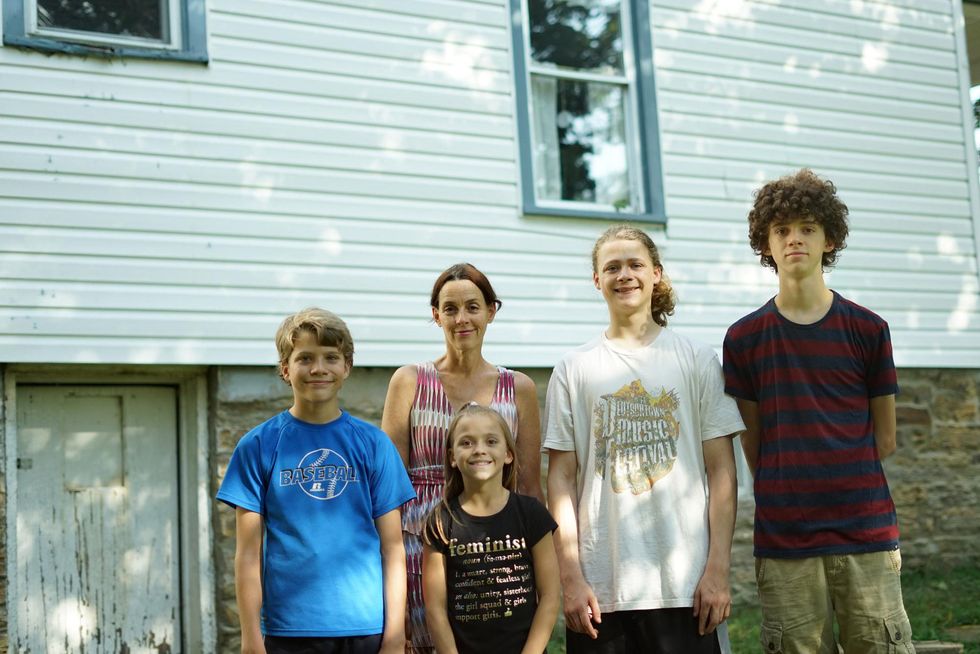
From left, Gunnar, Lois, Odessa, Nels and Kylan at their home in Scenery Hill, PA. (Credit: Connor Mulvaney for Environmental Health News)
"When we do air samples and we do urine samples we don't usually find naphthalene unless there's an industrial source releasing naphthalene very close by," Wilma Subra, an environmental scientist and founder of the environmental consulting firm the Subra Company, told EHN. Through her firm, Subra has spent decades conducting studies similar to EHN's in communities facing toxic exposures. She also previously served as vice-chair of the Environmental Protection Agency's (EPA) National Advisory Council for Environmental Policy and received a MacArthur fellowship for her work related to environmental exposures.
We all face myriad exposures to toxic chemicals every day—a byproduct of living in a modern world replete with vehicles, heavy industry, plastics, and pesticides. EHN's pilot study was small, and more research is needed to tease out fracking exposures and trends. Still, the exposures we found in Gunnar, his family, and four other southwestern Pennsylvania households suggest that the approximately 18 million Americans who live within a mile of an active oil and gas well might face above-average levels of exposure to chemicals that are harming them.
For many of those families, including the Bower-Bjornsons, the industry's proximity to their homes has not only led to anxiety about their health, but also damaged their quality of life, and made them feel disempowered and neglected by the federal and state agencies that are supposed to protect them.
A dream that became a nightmare

Lois Bower-Bjornson at her Scenery Hill, Pennsylvania, home. (Credit: Connor Mulvaney for Environmental Health News)
Washington County is about 93 percent White and mostly rural, dotted with aging mining towns. The exception is the county seat, a small city of the same name as the county that's home to Washington & Jefferson College and about 7 percent of the county's approximately 207,298 residents. Most of the county is middle class. The poverty rate is about 10 percent, a few points lower than the state poverty rate of 12 percent.
The Bower-Bjornson's picturesque white farmhouse, built in 1830, was originally the town general store. The walls of the large living room are shelved floor to ceiling, and on one shelf, left unpainted for posterity, there are lists of goods, quantities and prices, and tallies for what appear to be family tabs scratched in faded pencil.
The rest of the shelves are filled with books, a musically diverse record collection, and childhood memorabilia like school dioramas and lego houses.
As a young couple, Lois and her husband Dave lived in Pittsburgh's North Side on the historic Mexican War Streets, but after the arrival of their second child they started looking for more space. They saw this house in Scenery Hill and fell in love with the idea of an idyllic country life.
They moved in and enrolled the kids in a one-room elementary school where they spent their days practicing yoga, growing a garden, and helping prepare shared meals. Odessa, the youngest of the four Bower-Bjornson children, told EHN, "It's the best school in the world."

Gunnar and Odessa play in their family's Scenery Hill, Pennsylvania, home. (Credit: Connor Mulvaney for Environmental Health News)
When fracking companies arrived in 2011, the Bower-Bjornson's weren't worried—they saw an opportunity for economic growth. They granted one company permission to run natural gas transmission lines beneath their property for $12,500 (though they haven't leased their mineral rights). But over the next few years, the family's quiet country life morphed into something else.
Their property was surrounded by voluminous truck traffic, large flames shooting into the sky, bad smells, bright lights, loud noises, and an expensive ruptured gas line they chalked up to the increased traffic. They soon began to feel overwhelmed—and they're not alone.
In fracking towns across the country, residents have found themselves at odds over whether to lease their land and cash in or fight back against the industry. When formerly rural and suburban areas are suddenly industrialized by the fracking industry, research has found that residents' sense of place and identity are disrupted, and that living amidst fracking can increase worry, anxiety, and depression.
Concerns about water contamination have also persisted since the beginning of the fracking boom, when footage of tap water from homes near well pads catching on fire due to its high methane content went viral.
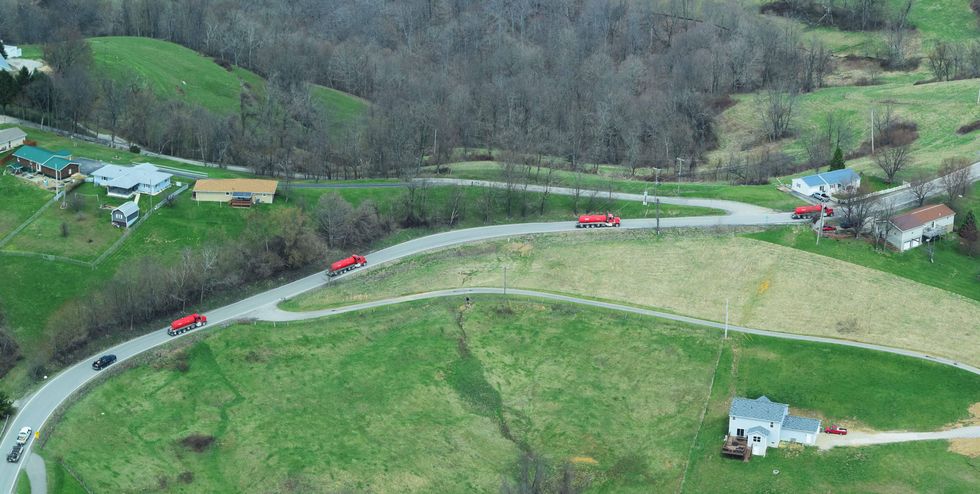
A line of fracking wastewater trucks in Moundsville, West Virginia (Credit: Ted Auch, FracTracker Alliance, 2019)
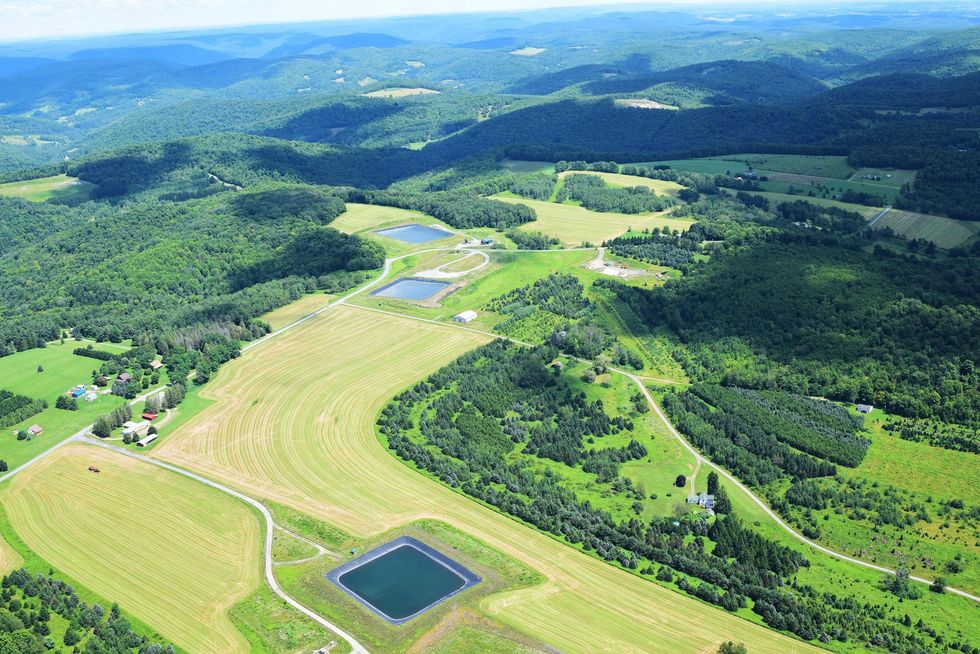
Aerial view of fracking wastewater storage ponds in central Pennsylvania. (Credit: Ted Auch, FracTracker Alliance, 2019)
Researchers have documented drinking water contamination from fracking in Pennsylvania, Ohio, North Dakota, and Wyoming at various points in time, and in 2016 the EPA concluded the industry posed a threat to the U.S. water supply. A literature review published in 2020 looked at a decade of research on the impacts of just fracking wastewater disposal and found that drinking water in fracking communities has higher levels of total dissolved solids (like calcium, magnesium, chlorides and sulfates), salt, and methane.
Kathleen Sgamma, president of the Western Energy Alliance, an industry group representing 200 unconventional oil and gas companies that operate in the Western U.S., told EHN that, while companies have always worked to minimize the chance of water contamination occurring, they've made some additional improvements in recent years.
"Wellbore integrity has been improving for decades and almost every state with a major oil and gas presence has tightened up its fracturing rules, so the risk of groundwater contamination continues to be managed to a very low level," Sgamma said. "When we look at surface handling of water, that's generally where spills can occur. It's rare for surface water to be contaminated, but when that happens it has to be remediated and companies are held liable for that."
"Nobody wants to have a spill for several reasons," she added. "One, because it takes a lot more money to clean up a spill than it does to just prevent it in the first place, and two, because it can harm a company's reputation." She added that companies have improved their ability to recycle wastewater, resulting in less freshwater use and helping to account for some of the wastewater disposal issues that have occurred.
The Bower-Bjornson's water comes from the local municipal system, Tri County Joint Municipal Authority, which serves more than 10,000 customers in southeastern Washington County. For the last several years, the Bower-Bjornson family has received notices from the municipal water authority and the Pennsylvania Department of Environmental Protection's (DEP) Bureau of Safe Drinking Water stating that the municipal water contains unregulated chemical contaminants including haloacetic acids, total trihalomethanes, nitrates, and inorganic compounds, among others. The notices advise anyone who is pregnant, has an infant, has a compromised immune system, or is elderly should consult with a physician before drinking their tap water.
Brothers Kylan Bjornson and Nels Bjornson in their home in Scenery Hill, Pennsylvania. (Credit: Connor Mulvaney for Environmental Health News)
The oil and gas industry is one likely source of these contaminants, along with mining and other heavy industries. Some contaminants, such as trihalomethanes, are formed when contaminants in source water interact with chemicals used for treatment.
Sydney Evans, a science analyst at the Environmental Working Group, a public health advocacy nonprofit, told EHN that few federal or state water regulations have been updated in the last 20 years, so there's a gap between what's legal and what's safe.
"People tend to take the safety of their tap water for granted because it's being monitored, tested, and treated," Evans said. "But it's important for people to realize that legal doesn't necessarily mean safe."
Most public drinking water in the region comes from the Monongahela River (or "the Mon," in local parlance). In 2014, the DEP found radioactive chemicals at levels 60 times higher than what federal drinking standards allow in Ten Mile Creek near the Bower-Bjornson's home, which feeds into the Mon, and many locals feel certain fracking wastewater is the source.
Last year, it was discovered that a municipal sewage plant in nearby Belle Vernon was unknowingly accepting and releasing untreated fracking leachate from a nearby landfill containing high levels of chlorides, barium, and radium at higher levels than federal drinking water standards allow into the Mon—one of many similar instances across the state.
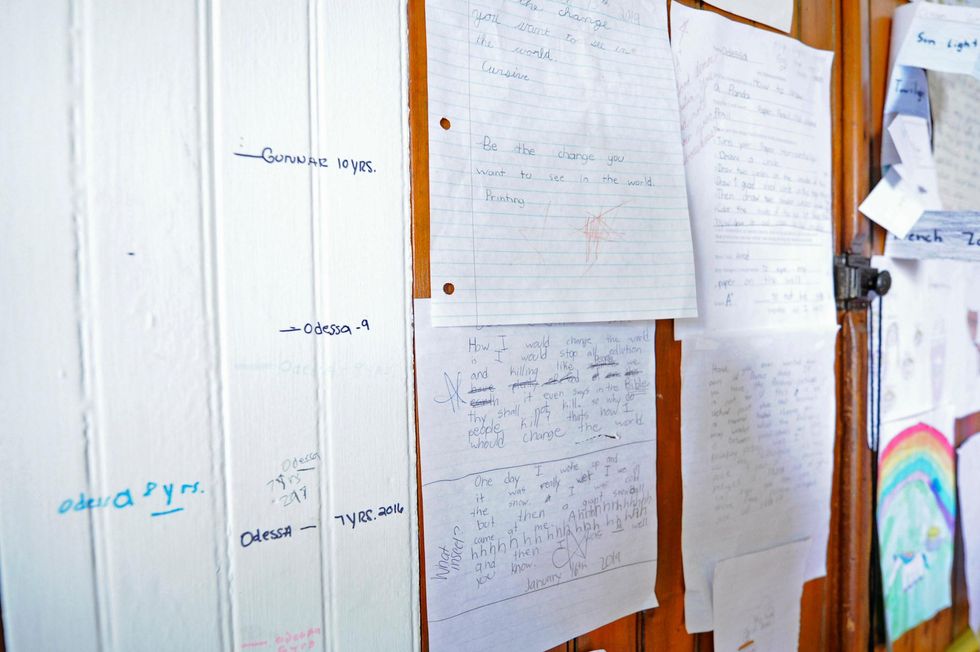
Marks for children's growth in the Bower-Bjornson home. (Credit: Connor Mulvaney for Environmental Health News)
At the beginning of the summer of 2019, EHN collected water samples from three locations in the Bower-Bjornson's family's home: The reverse osmosis-filtered kitchen tap, the bathtub faucet, and the outside hose spigot. We found detectable levels of 20 of the 40 chemicals commonly used in fracking that we looked for in samples from at least one of those locations, including benzene, which is known to increase cancer risk, and naphthalene, which is listed as "possibly carcinogenic to humans" by the EPA.
Federal regulatory limits exist for just five of the 40 chemicals we looked at, and the family's water samples did not exceed those limits. Some states set health advisory limits for chemicals that aren't officially regulated. Vermont recommends no more than 0.5 micrograms per liter of naphthalene in drinking water to avoid health effects including increased cancer risk. The Bower-Bjornsons had 5.83 micrograms per liter of naphthalene in their water—nearly 12 times as high as Vermont's health advisory limit. Tri-County Joint Municipal Authority declined to comment on these findings.
Lois, who has been tracking the kids' symptoms since the drilling began, said that seeing these test results confirmed what she already feared.
"[Fracking] just completely encompasses us," she said. "It's not like we can look to our right or left and say it's not there. And everywhere that they go, school or wherever, it's there too."
Economic gains in question
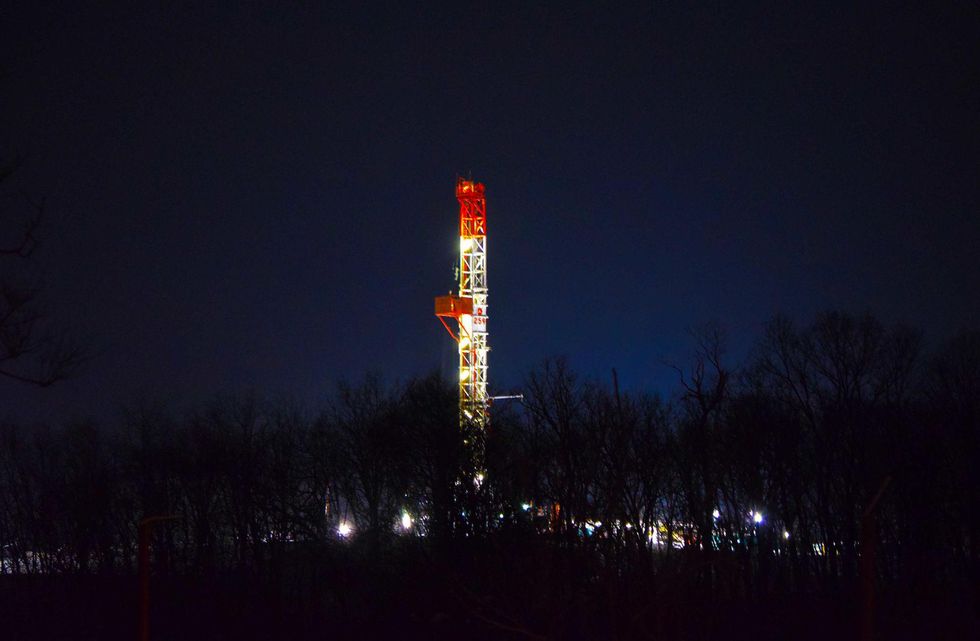
A hydraulic fracturing drilling rig in western Pennsylvania at night. (Credit: Ted Auch, FracTracker Alliance, 2015)
Fracking does bring economic benefits—at least temporarily. A 2019 paper in American Economic Journal: Applied Economics found that in the initial three years of a boom, fracked communities typically see total incomes increase by around 3-6 percent, employment increase by about 4-6 percent, and salaries increase by about 5-11 percent. Housing prices increase about 6 percent, while local governments see about a 16 percent increase in revenue.
Taking into account both increased incomes and decreased quality of life (from things like increased crime rates, truck traffic, and pollution), the authors of that study concluded that in regions where fracking occurs across all U.S. shale plays, the industry resulted in an average net gain of approximately $2,500 per household in the first three years—though some communities saw much higher gains and others saw none.
Over time, these impacts on local economies are diminished. A study published in February, 2021 by the Ohio River Valley Institute, a nonprofit think tank, revealed that while economic output in Appalachian fracking counties grew by 60 percent from 2008-2019, the counties' share of the nation's personal income, jobs, and population levels all declined.
The study looked at the 22 counties in Ohio, Pennsylvania, and West Virginia that produce more than 90 percent of the region's natural gas. In 2008, those counties were responsible for $2.46 of every $1,000 of national economic output. By 2019, the counties were generating $3.31 of every $1,000 generated nationally—an increase more than triple the rate of national growth. But over the same period, those counties' share of the nation's personal income fell by 6.3 percent, their share of jobs fell by 7.5 percent, and their share of the nation's population fell by 9.7 percent. The analysis concluded that about 90 percent of the wealth created from shale gas extraction leaves local communities.
Related: Appalachia's fracking boom has done little for local economies
Among the three states the report looked at, Pennsylvania's showed the best prosperity measures, and some Pennsylvania counties performed better than others—Washington County fared the best, with a personal income growth rate that slightly exceeded national growth, and job growth equal to the national rate, while five of the other seven Pennsylvania counties either gained very few jobs or experienced a loss.
Diana Irey Vaughan, chair of the Washington County Board of Commissioners, said the industry has transformed the local economy.
"The oil and gas industry has had a tremendous positive impact on our economy," Vaughan told EHN. "For example, from 2000 to 2018, our median income grew from $47,287 to $78,895." She also pointed to a U.S. Bureau of Labor and Statistics report that ranked Washington County third in the nation in job growth from 2010-2011, right at the beginning of the region's fracking boom.
Vaughan said that Washington County has been able to maintain low property taxes in part due to fees the county receives from the oil and gas industry.
Since 2012, the industry has had to pay an "impact fee" for each well pad in Pennsylvania to help cover its negative impacts. Those fees are distributed to the state and local governments, which typically use them for infrastructure projects, public safety, and emergency preparedness. Environmental advocates say the fees are too low to address all of the environmental issues the industry causes. But many local governments rely on the fees. The money collected from impact fees in Pennsylvania dropped in 2019, but Washington County still collected $6.6 million—more than any other county in the state.
"This has allowed us to advance capital projects without taking money from our general funds or tax dollars," Vaughan said. She added that the county has also sold mineral leases on county-owned properties including parks, airports, and fairgrounds and used the lease and royalty payments to make improvements to those properties.
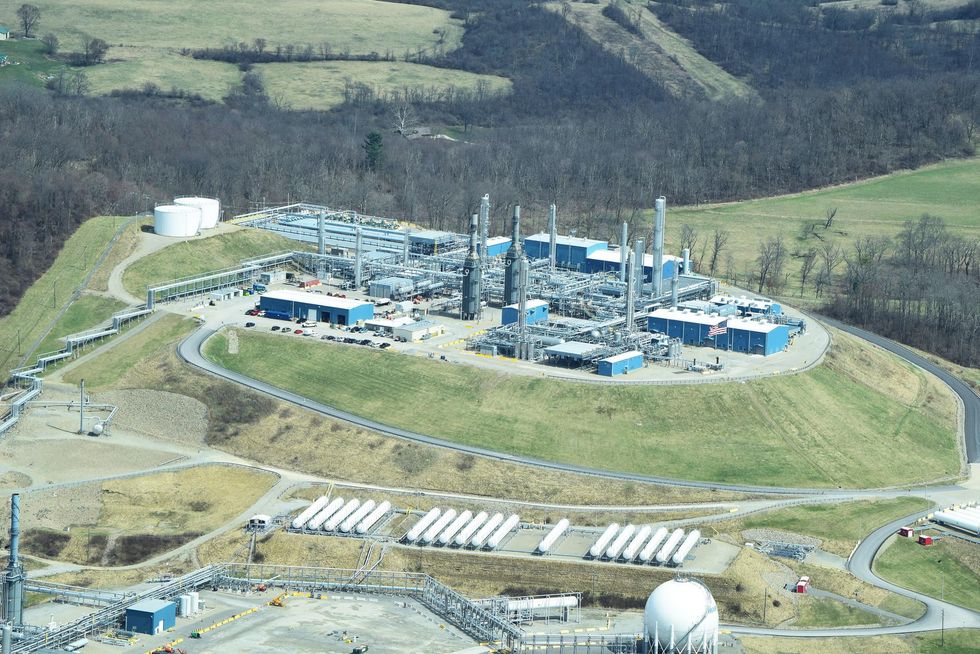
Aerial view of the Mark West natural gas processing plant in Washington County, Pennsylvania. (Credit: Ted Auch, FracTracker Alliance, 2019)
Unlike many other states, Pennsylvania does not collect a severance fee from oil and gas operators. In Texas, for example, the state collected $1.69 billion in taxes and fees from natural gas production—more than eight times as much as the approximately $200 million Pennsylvania collected in impact fees the same year. Democratic Pennsylvania Governor Tom Wolf has repeatedly attempted to enact a severance tax on the natural gas industry, but those efforts have been thwarted by the Republican-controlled legislature, whose members say it will hinder the growth of the industry and harm local economies.
Many state lawmakers still believe the industry has been good for Pennsylvania. "It's the biggest industry to come to Pennsylvania in the last 50 years," Republican Senator Gene Yaw, who chairs the state Senate Environmental Resources and Energy Committee, told EHN. "We tried to get Amazon to come to Pittsburgh or Philadelphia and we were putting together programs that totaled billions of dollars in subsidies. The gas industry has already come here and they've asked for very little."
Yaw has advanced numerous pieces of legislation aimed at helping the industry expand in Pennsylvania, and has also attempted to block states with fracking bans from buying Pennsylvania's natural gas. He also leases his own mineral rights—his 2018 financial disclosure showed that he received income from five drilling companies through leases on land he owns (but does not live on).
When it comes to job creation, Kathy Hipple, a financial analyst at the Institute for Energy Economics and Financial Analysis (IEEFA) and finance professor at Bard College, said numerous studies have shown the industry often over-promises the number of permanent jobs it will create.
"In the Pittsburgh region especially, there's been an almost desperate search for the next steel industry because that's remembered as a really great time in Pittsburgh's history," Hipple told EHN. "But the reality of the fracking business is that it's a lot of jobs at the beginning for construction that are often filled by people who aren't from the local area. Due to the technological advances—which the industry should be applauded for in a sense, as it's become quite proficient at producing oil and gas—the later stages don't require very much of the labor force at all, whether local or out of town."
The American Petroleum Institute has claimed that the industry supports nearly 500,000 jobs in Pennsylvania, but data from state and federal labor departments show there are actually about 26,000 fracking-related jobs in the state. Statewide, this means the industry isn't even among the top 50 sectors that employ Pennsylvanians.
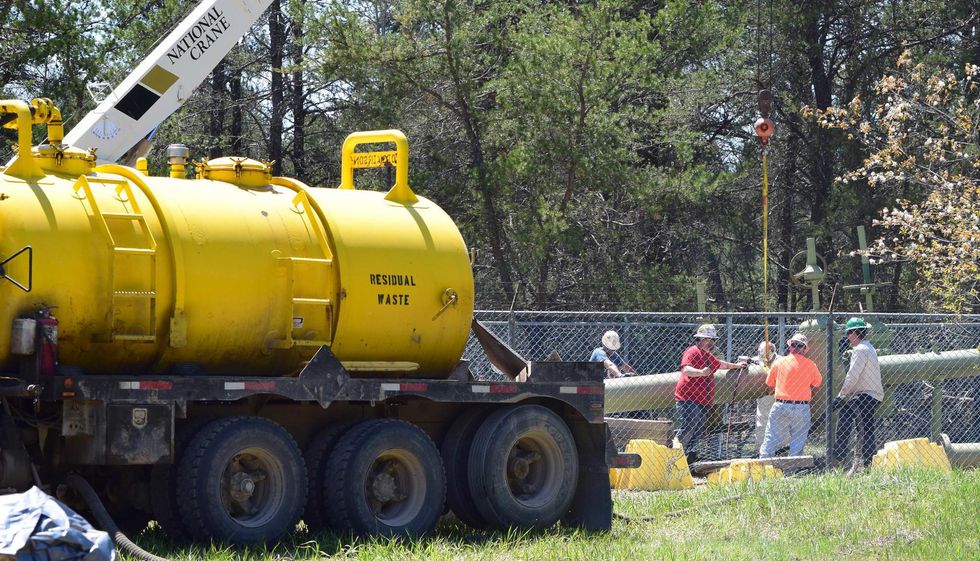
Natural gas construction in Michigan. (Credit: Ted Auch, FracTracker Alliance, 2016)
"The nearly 500,000 jobs, which is taken from an analysis conducted by PwC [PricewaterhouseCoopers], represents total industry jobs supported in Pennsylvania including refining, transportation, and distribution, not just drilling, production and development jobs," Emily Smith, a spokesperson for the American Petroleum Institute, told EHN in an email, adding that data from the Bureau of Labor Statistics data only includes salaried jobs, which excludes private contractors. "According to the U.S. Bureau of Economic Analysis, salaried jobs only represent approximately 30 percent of the oil and gas extraction sector...on a national basis."
Some research suggests that the ultimate cost-benefit ratio of the industry may actually skew negative. A 2019 study by researchers at Princeton, Carnegie Mellon, and Stanford Universities estimated that air pollution from the fracking industry caused between 1,200 and 4,600 premature deaths in the Marcellus and Utica shale plays spanning Pennsylvania, Ohio, and West Virginia from 2004-2016. During the same time period, the industry created a regional economic boost of approximately $21 billion dollars, but those gains were overshadowed by $23 billion in public healthcare costs related to those premature deaths.
Meanwhile, as a result of the recession spurred by COVID-19 pandemic, the oil and gas industry nationally lost more than 100,000 jobs last year.
In the air
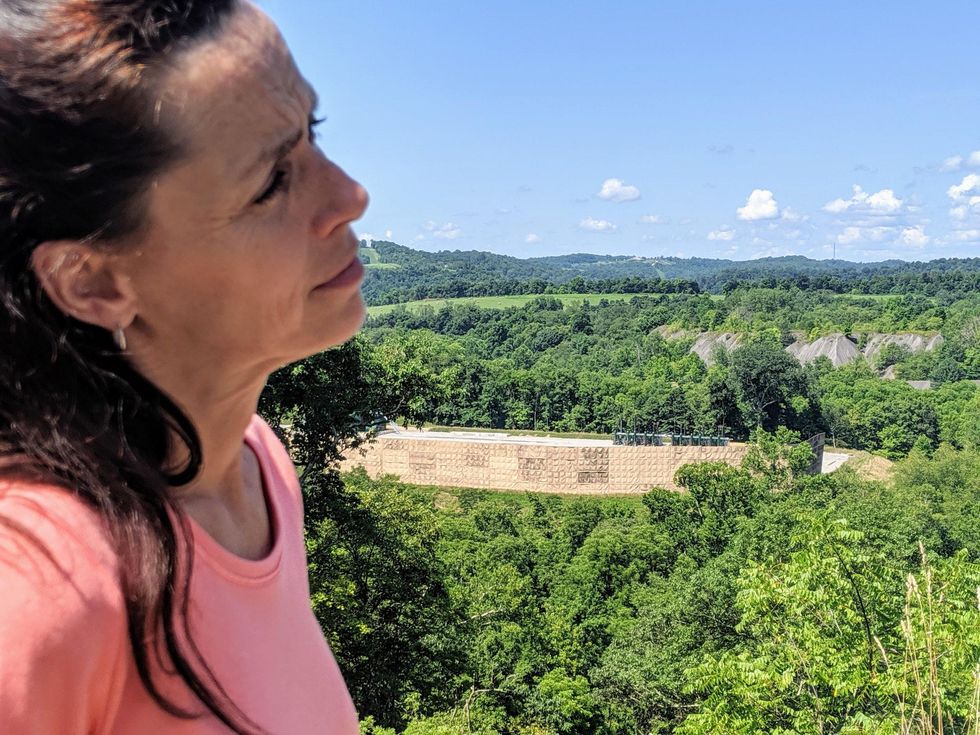
Lois Bower-Bjornson stands in front of an under-construction fracking well pad in Washington County, Pennsylvania. (Credit: Kristina Marusic for Environmental Health News)
Lois, who is tall and willowy with dark hair, pale skin, and large, luminous eyes, worked as a model and professional dancer before having kids. She still moves through the world like a dancer—she's often in motion, and is prone to standing on one leg with the opposite foot casually propped up against her knee like a flamingo.
In addition to teaching several dance and yoga classes a week in her barn-turned-dance-studio, Lois also runs a residential green cleaning business and works as a paid part-time organizer for the Clean Air Council—something she felt compelled to do after growing increasingly alarmed about the apparent impact that fracking was having on the region's air quality.
The fracking process typically involves as many as 1,000 chemicals including solvents, surfactants, detergents, and biocides, and air monitoring studies have detected more than 100 chemicals in air emissions from the sites, including benzene, toluene, ethylbenzene, xylene, and mercury. A 2019 study found that air pollution from fracking wells specifically killed an estimated 20 people in Pennsylvania from 2010-2017, and that higher-than-average levels of air pollution can be detected as far as six miles downwind of a well pad.
During the summer of 2019 when EHN collected urine samples from the Bower-Bjornsons, we also had them wear personal air monitors. Each family member wore an air monitor attached to a pump that mimics breathing by pulling in air for six to eight hours leading up to the collection of their first two urine samples. (On a third date, we collected one additional urine sample without any air monitoring.) The samples were analyzed for the presence of 40 chemicals that air monitoring studies have reported as frequently emitted during fracking.

Odessa Bjornson and Damien Shaffer play at the Bower-Bjornson home in Scenery Hill, Pennsylvania. (Credit: Connor Mulvaney for Environmental Health News)
On August 6, 2019, Gunnar's air monitor recorded the highest levels of both n-propylbenzene and 1,3,5-trimethylbenzene detected among 39 total air samples EHN collected from five southwestern Pennsylvania households. Gunnar helped his dad paint and scrape vinyl flooring at his sound studio in Pittsburgh that day, which could have contributed to these exposures. On the same day, Lois's air monitor recorded the highest levels of hexanal, ethylcyclohexane, and octane seen in our study. She cleaned two houses using "green" cleaning products that day, which could have contributed to these exposures.
Only a handful of these chemicals have legal limits or even non-enforceable health-based guidelines, most of which pertain to short-term workplace exposures. The Bower-Bjornson family's air samples exceeded one state guideline for three chemicals—the recommended limits on benzene, ethylbenzene, and naphthalene exposure set by the California Office of Environmental Health Hazard Assessment to keep cancer risk below one in a million.
"It's always a little hard to interpret what's meant by 'excess cancer risk,'" James Fabisiak, a toxicologist at the University of Pittsburgh Graduate School of Public Health, told EHN. "One in a million is sometimes used as a benchmark for negligible risk, but most of us don't have a risk that low. I don't think you would see EPA take or recommend action until risks were in the range of one in 10,000 to one in 100,000. There's some gray area between what amounts to 'no risk' and what amounts to 'actionable risk.'"

Bjornson kids on the move. (Credit: Connor Mulvaney for Environmental Health News)
Fabisiak also compared EHN's air monitoring findings against those of two large surveys that measured volatile organic compounds in average homes in the U.S., and found that most of the levels detected in the Bower-Bjornson's air monitors fell within the ranges found in those studies, though some compounds were near the high end.
"If I knew these concentrations were there all the time in my own home," he said, "I might think about how I could get them back closer to the average."
Fabisiak added that while the risk associated with the level of each individual compound may not be a problem, high levels of numerous compounds within the same household have an additive effect—combining with one another and interacting with lifestyle and genetic factors in unpredictable ways that amplify overall risk.
"That's especially true of those air pollutants that affect common diseases like asthma and cancer," Fabisiak explained.
The Bower-Bjornsons and other residents of Washington County have also worried that the increased air pollution from fracking makes them more vulnerable to COVID-19. In the spring of 2020, nonprofit community health advocacy organization the Southwest Pennsylvania Environmental Health Project* (which helped connect EHN with families that were interested in participating in our research) conducted an informal literature review on air pollution and respiratory infections to help educate southwestern Pennsylvania residents about the links between the two.
"Based on what we saw in numerous studies that have dealt with diseases similar to COVID-19, we know that increased exposure to particulate matter pollution makes the symptoms of infectious lung diseases worse," Alison Steele, executive director of the Southwestern Pennsylvania Environmental Health Project, told EHN.
Lessons learned
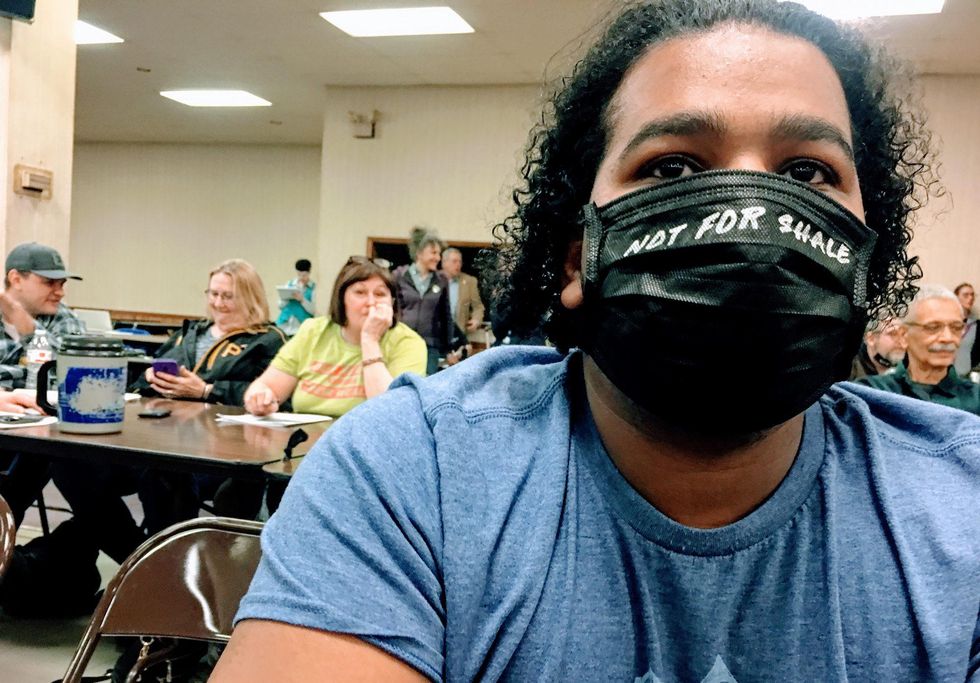
An activist wears a face mask to protest poor air quality caused by fracking, pre-COVID-19, at a 2019 community meeting in Braddock, Pennsylvania. (Credit: Kristina Marusic for Environmental Health News)
Lois is no stranger to the region's history of industrial extraction. She grew up in Fredericktown, a nearby coal mining town, splitting her time between the hotel her grandparents built and the former apple distillery her great-great-great-great grandparents built.
She and the neighborhood kids used to watch coal barges float down the river and ride dune buggies on slag dumps—piles of toxic, rubbly waste generated by coal processing. They also swam in the river, even though it was sometimes oily from industrial residue, raw sewage poured in from the municipal pipes, and river rats abounded.
"We knew it might be harmful, but so many people's parents were coal miners that potential for harm just seemed like a normal part of life," she said.
She sees those same attitudes persisting when it comes to fracking—and especially when it comes to the impending petrochemical boom in the region.
In 2016, Royal Dutch Shell began construction on a massive ethane cracker in Beaver County, about 33 miles northwest of Pittsburgh and 57 miles north of Scenery Hill. The plant, which is now nearly complete, will eventually convert a massive volume of natural gas and liquids into 1.8 million tons of polyethylene every year for use in plastics manufacturing. It's one of up to five such facilities that have been proposed in the Appalachian basin region spanning Pennsylvania, Ohio, and West Virginia—though all but the Shell project have been indefinitely put on hold due to unfavorable market conditions.
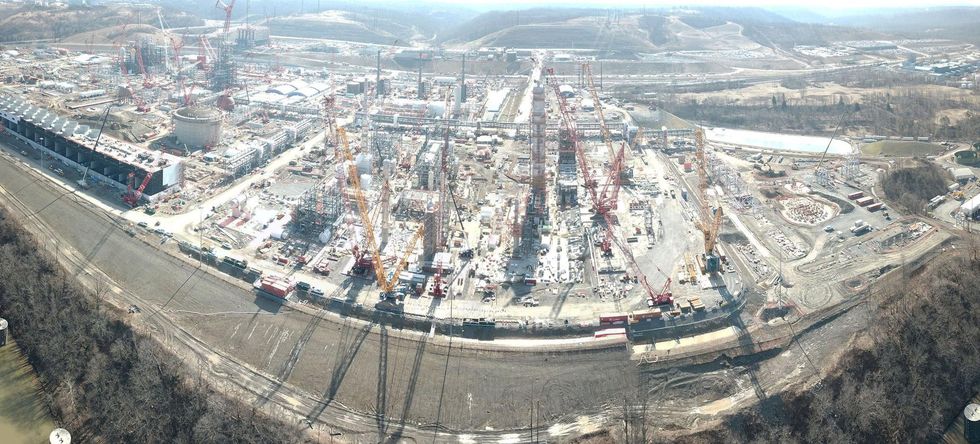
Construction site of the Shell ethane cracker in Beaver County, Pennsylvania. (Credit: Ted Auch, FracTracker Alliance, 2019)
Four of the proposed locations sit directly alongside the Ohio River or one of its tributaries, and each facility will demand natural gas liquids from an estimated 1,000 new fracking wells per year, according to researchers at Duquesne University. A similar petrochemical corridor in Louisiana has some of the worst air pollution and highest cancer rates in the country, resulting in the region being dubbed "Cancer Alley."
Southwestern Pennsylvania already has cancer problems. The region has higher than average rates of the types of cancer associated with air pollution, and in 2019, the Pittsburgh Post-Gazette documented 27 cases of Ewing sarcoma—a one-in-a-million bone and soft tissue cancer—in Washington, Greene, Fayette and Westmoreland counties over the last decade. These counties combined have a population of about 750,000 and are where a majority of the state's fracking occurs, and amid concerns about radioactive waste from the oil and gas industry being mishandled, residents have demanded answers from elected officials. Investigations are ongoing, but so far no link between the rare cancers and the oil and gas industry has been confirmed.
Shell applied for air pollution permits that were approved back in 2015, but submitted a new permit application in February 2020 that seeks lower emissions levels for some pollutants, but much higher levels of others, including greenhouse gases.
For years, local environmentalists, community members, and Indigenous groups have fought to stop the petrochemical buildout, but despite their efforts—and warnings from financial analysts that the industry isn't a viable long-term investment—many local policymakers have welcomed the jobs the industry promises.
"In the 70s and early 80s we saw the demise of the steel industry and what it did to our economy—we saw our friends and family members move away because the jobs were gone," Democratic Pennsylvania State Representative Robert Matzie told EHN. Matzie's district is adjacent to the site of the Shell ethane cracker, and Matzie was one of a handful of Pennsylvania Democrats to support the project from its outset. "As policymakers we have to weigh and balance both protecting the environment and having good jobs that take advantage of our natural resources, and I believe we can have both."
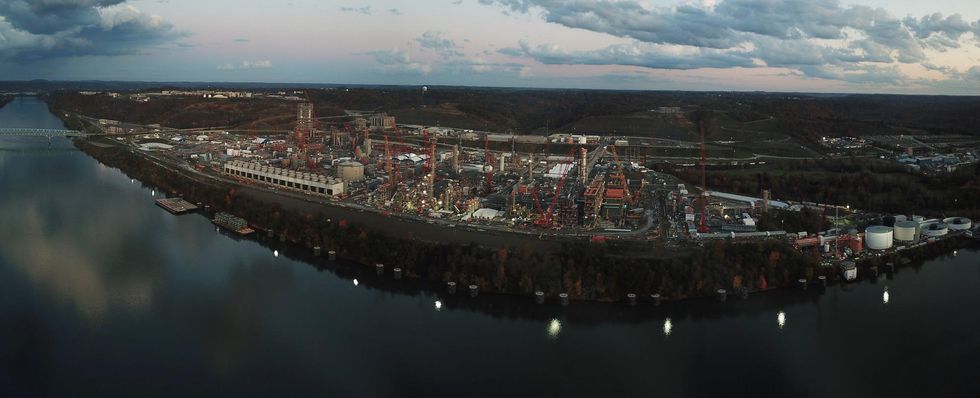
Construction site of the Shell ethane cracker in Beaver County, Pennsylvania, at night. (Credit: Ted Auch, FracTracker Alliance, 2019)
Matzie said the plant is projected to create 10,000 to 15,000 jobs in a 50-mile radius. At the same time, he said some of his constituents fear becoming another "Cancer Alley."
"I live a stone's throw from the site," Matzie said. "Me and my family have to drink that water and breathe that air too." He added that he believes this plant will be different because it's newer than the ones in Louisiana and will use the best available technology to minimize environmental impacts.
In the past, Matzie has also introduced legislation aimed at keeping fracking wells at least 4,000 feet away from dams and reservoirs in an attempt to protect his own district's water reservoir. So far he has been unsuccessful.
"Right now you can drill right in the middle of a freshwater source," he said. "I have a problem with that. You can show me all the technology that says it's safe—I still don't want to see it."
In lieu of that legislation, Matzie says he helped negotiate additional protections for the reservoir from the natural gas pipeline that will feed the Shell ethane cracker—things like a thicker steel lining and easier access to emergency shutoff valves—by working directly with the company.
"Shell stepped up and went above and beyond current policy and statutes for the pipeline," he said, adding that he has also championed solar energy projects, serves as co-chair of the state's nuclear energy caucus, and welcomes any industry that would bring jobs to his district.
This issue might be complex for politicians, but for 13-year-old Gunnar, it looks simple.

Lois Bower-Bjornson is no stranger to the region's history of industrial extraction. "We knew it might be harmful, but so many people's parents were coal miners that potential for harm just seemed like a normal part of life." (Credit: Connor Mulvaney for Environmental Health News)
He doesn't like getting nose bleeds, he doesn't like his mom worrying, and he's worried about climate change—which he knows fracking contributes to. "The only reason people don't think climate change is real is because they're afraid of it," he told EHN. "I think fracking is noisy, annoying, reckless, and kind of idiotic. I wish we could move away just to be able to actually get some sleep."
Vaughan, the chair of the Washington County Board of Commissioners, said she rarely hears from people who've experienced negative impacts from the industry. She acknowledged community concerns about the childhood cancer clusters, but said, "We have not seen scientific proof that there is a correlation between the two," and pointed to other industrial sites in the region that could be contributing to potential environmental exposures.
"There are times when you have inconveniences with noise or lights or trucks," she added, "but I think the majority of people in Washington County have been willing to tolerate these things for the greater benefit," she said. "This area was also very rich in coal reserves and had previously welcomed mining to our region. Prior to that we also had the steel industry. So I think this region is more accepting of those types of inconveniences than other regions because of our history."
Lois sees it differently.
"It's almost a bizarre genetic trait among people in this region that this is just always what we do," Lois said. "We keep going back again and again, trading our health for jobs. At what point do you learn your lesson and not keep doing the same thing over and over again?"
Frequently Asked Questions about Fractured: What to do, who to call, how to push for change.
Have you been impacted by fracking? We want to hear from you. Fill out our fracking impact survey and we'll be in touch.
In part 2 of this series: The mental health and social toll of feeling surrounded by fracking wells and pollution.
This story was fact-checked by Dani Leviss.
*The Southwestern Pennsylvania Environmental Health Project and EHN both receive funding from the Heinz Endowments
- Living near fracking wells linked to early death - EHN ›
- One year after our “Fractured” investigation on fracking: What’s changed? - EHN ›
- Public health in Pennsylvania ignored during fracking rush: Report - EHN ›
- How the “Halliburton Loophole” lets fracking companies pollute water with no oversight - EHN ›
- Fracking risks for childhood cancer, low birth weights, asthma - EHN ›
- Appalachia’s fracking counties are shedding jobs and residents: Study - EHN ›
- 800,000 tons of radioactive waste from Pennsylvania’s oil and gas industry has gone “missing” - EHN ›


















